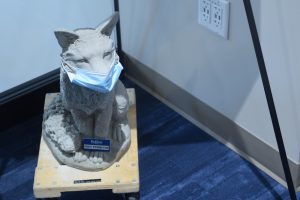Last semester, Molly Fulop ‘20 “had a cough, sinus drainage, and throat pain.” After about a week of symptoms, Fulop visited the Wellness Center.
In her appointment, Fulop was told by a Wellness Center nurse practitioner that the mold in Ward was most likely contributing to the sickness lasting so long, and its severity.
Fulop fully believes that her symptoms were due to an environmental factor at Rollins, as her symptoms stopped when she went home for Thanksgiving break and then resumed upon her return to campus. To combat her symptoms, she has been using an asthma medication prescribed to her by the Wellness Center.
Aurelia Jean ‘19, a student with asthma, claimed that she was also sick in Ward last spring. Jean expressed that her asthma was almost gone and then reappeared last semester. “My gastric reflux came back too,” she explained.
Jean now lives in Rollins Hall, where her symptoms have been the worse thus far.
When Jean went to the Wellness Center, she was told it was “an environmental factor,” so she requested an air quality test. Jean said, “They did an air test in my room and didn’t find anything.”
However, Jean is still convinced that her symptoms are due to environmental allergens and mold on campus, as, like Fulop, Jean’s symptoms went away whenever she went home.
The presence of mold in the environment most prominently impacts the respiratory system. According to Denise Snyder, assistant director of the Wellness Center, “Individuals with exposure to mold or other allergens may experience allergy symptoms such as runny nose, congestion, and/or cough… [while] individuals with respiratory illnesses, such as asthma, may experience exacerbations of their asthma from their environmental exposure.”
While Fulop received medication to combat her symptoms, other students have been forced to move in order to escape the adverse impacts of what they believe is tied to mold. This is what Brooke Worthington ‘21 had to do.
“I basically just moved out of McKean because I had a cough, and it went away over Winter Break but then came back when I moved back into the dorm.”
Worthington took precautionary measures in case it was caused by her room environment after one of her friends did the same. She did not have her air quality tested, though. “I had a friend that moved out and said it helped so I thought I’d try it,” she recalled.
Multiple other students aside from Fulop, Wellington, and Jean have reported similar symptoms within the past semester. However, when asked, Snyder said, “The Wellness Center has not had any known mold related cases last semester.”
Students living in Gale Hall (home to X Club, Rollins’ local fraternity) have had facilities in and out of their rooms testing the air quality and wiping down their walls.
Ryan Tillotson ‘20 also experienced frequent illness in the fall and his mother urged him to have his air quality tested. “Last semester, I started feeling sick so my mom wondered if there was mold in my room. They did a test and cleaned it out.”
However, as of last week, faint dark colors were beginning to reappear in the same areas of the walls above his bed.
“It’s reappeared and they have started doing air quality tests again to address it,” he explained.
Scott Rayburn, safety and emergency planner, explained the current procedures in place to measure air quality: “There is no ‘schedule’ for air quality testing. We perform tests when requested, usually by staff from Facilities Management or Residential Life & Explorations. These requests are generally triggered by the discovery of staining, odors, or excess moisture.”
He went on to clarify that, “At present, we have not determined that there is a mold problem in Gale Hall. All testing has indicated lower levels of spores inside the building than outside. The levels that we are seeing are at relatively low levels. This leads us to believe that the HVAC [heating, ventilation, and air conditioning] system is operating properly.”
According to Rayburn, “In 2017, approximately 47 tests were performed on a variety of campus buildings—administrative, residential, sports, and classroom areas.” Rayburn stated, “No test results have been ‘extra-ordinary,’ or significant in the past 3 years at residence halls. RLE works closely with us to facilitate testing, and assists students who might be having issues.”
In his experience, he largely discovered mold growth “in residential and administrative rooms in old laundry, shoes, houseplants, and food.”
He continued, “Thermostats in all rooms should be set to ‘auto’—this will ensure proper functioning, as it allows the unit to adjust automatically to environmental conditions. There is a misconception that a cold room with the AC fan constantly running will eliminate humidity. These settings can actually cause condensation—moisture—that contributes to mold and mildew growth.”
Oliver Santry ‘19, also a resident of Gale, explained that the relative humidity of his room is 67 percent.
According to the American Society of Heating, Refrigerating, and Air-Conditioning Engineers (ASHRAE), relative humidity levels should be kept between 45 and 55 percent to manage health effects and illnesses.
Santry has asthma and recalled having to sleep in the common room of his fraternity house one night because the conditions became so unbearable.
“At one point it was so humid in here, and I felt so sick from it, I slept downstairs in the chapter room,” he said.
Mold growth in dorm rooms is typically facilitated by the misuse of air-conditioning settings and—for dorms that still have an openable window—open windows letting in extra moisture that the current air-conditioning systems are unable to filter out.
Santry did admit to removing the seal on his window, but he claims that, regardless, he almost always kept it shut.
Mold in campus dorms has been a major issue across colleges in the South.
Morris College, in South Carolina, is currently being sued for $55 million in damages by five students who claim that “unsafe living conditions, including mold and other problems, were reported to the school’s administration four years ago but have gone unresolved.” Students were reportedly hospitalized and some even dropped out because the conditions were so bad.
In 2011 and 2012, Maryland’s College of Saint Mary relocated 250 students, 40 students were forced to move out at the University of Delaware, as were 270 students at University of Louisville. All of these instances were related to mold growth in residential halls.
Rollins is currently in the process of installing new methods to control the temperature and humidity levels of residential halls to prevent any extreme instances, like those listed above, from occuring.
David Markland, maintenance shop superintendent, explained that, “The campus has been moving towards non-operating windows and changing thermostats for programmed settings that will reduce room air issues. As we remodel and build, newer dorms will have improved controls and set-points that reduce any air-quality concerns. Referencing our newer, remodeled dorms, they have almost no air-quality calls during the year.”
He continued, “Facilities everywhere are always striving for reduced calls and issues with air quality. Since we have been moving in that direction, the number of calls have been reduced and continue to be reduced.”
Markland also clarified that maintenance changes all dorm room air filters twice a year, before each semester and during summer maintenance and winter break, or when there is a request for a dirty filter to be changed.
“During our summer maintenance they will clean the coils, replace the filter and adjust the controls if needed. The best way to reduce these issues will almost always be the user, they will need to follow the guidelines for A/C unit control (auto only) and temperature not below 72 degrees.”
While following the suggested guidelines are preventative measures for mold growth in rooms, if anyone is concerned about a dorm room’s air quality, you should have a member of facilities test it immediately.













Be First to Comment